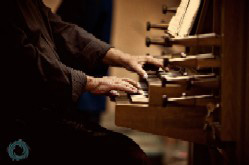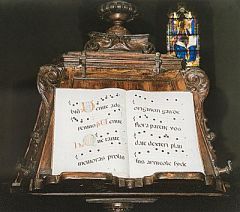

|
| Musical Musings: Liturgy |
|
|
Liturgical Music Curriculum in RomeThis article is appeared in the May 21, 2013 online edition of the National Catholic Register, as a Catholic News Agency feed. It is reprinted with permission.
"The most important thing is that music, when it is truly liturgical, creates community," said Father Jordi Piqué, dean of the Pontifical University of Saint Anselmo’s liturgical institute. "When one hears a Mass that is sung or the organ interpreting a beautiful melody, it’s never individualistic; it’s always as a group," he added, speaking at the Benedictine abbey where the university is located. Father Piqué, who plays the organ, is from the Benedictine Abbey of Montserrat, Spain, and was named dean of the program in December 2012. "The Pontifical Liturgical Institute has always had liturgical sources as its base, and since the Second Vatican Council, studies have been adapted to spread and make liturgy [to] be valued by the faithful," he explained. "A very important part of liturgy is the music and chants, and now we’ve been able to unite with the Pontifical University of Sacred Music and offer this master’s degree." The degree will require that students study Gregorian chant with "a scientific reflection," as well as seeing its central place, "directed within the liturgy." Classes for the two-year program will be held every Thursday evening and will be divided into three main topics: liturgy, music and theology. The university will regularly invite speakers to lecture on topics such as organ improvisation, the sources of Gregorian chant and music composition. Students will also learn about how to use the principles of Gregorian chant to compose chant in their own vernacular languages.
"The biggest challenge of liturgical music is the same as it has always been: to take modern-day musical languages and translate them into liturgical languages or vice versa," reflected Father Piqué. "We have to invite composers to adapt popular and modern-day music, but within the environment of the (Eucharistic) celebration." Father Piqué believes that music can help people pray, but that liturgical celebrations should include times of silence as well. "Music needs silence," he stated. In explaining the essential link between Gregorian chant and the Roman liturgy, Father Piqué noted the well-known dictum commonly attributed to Saint Augustine: "He who sings prays twice." Saint Benedict directed his monks to "sing with pleasure, sing with wisdom," he added. He noted that liturgical participation includes not only singing the chants, but attentively listening to them as well. "Whoever sings or listens to music is praying," he explained, "because you are praying when you are listening," and "by singing, you reveal what your heart contains." He also believes that sacredness has not been lost, but is "transforming itself and taking on new forms that are related to our times." Father Piqué noted the increasing use of Gregorian chant at Mass and interpreted it as a refuge from the hurried pace of modern life. Father Piqué said, "Our times are very filled with noise, and so music within the liturgy is taking on again the calm, tranquil and serene aspect that this open and serene dialogue with God needs to have." Copyright © 2013 EWTN News, Inc. All rights reserved. Reprinted with permission. |
Submit Your Music / Contact Us / Company Description / Links
 A pontifical university in Rome has launched a master’s program in Gregorian chant and the use of the organ at Mass so as to build unity among Catholics worldwide.
A pontifical university in Rome has launched a master’s program in Gregorian chant and the use of the organ at Mass so as to build unity among Catholics worldwide.
 There will also be guests for the course, including the president of the Pontifical Council for Culture, Cardinal Gianfranco Ravasi, who will lecture on the vision of music within the liturgy.
There will also be guests for the course, including the president of the Pontifical Council for Culture, Cardinal Gianfranco Ravasi, who will lecture on the vision of music within the liturgy.